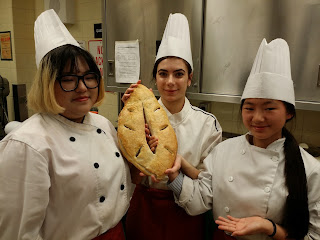There are two things you can say about good fougasse ... 'YUM', and 'Wow, how did you make that excellent bread?'
Let's just leave the YUM and go to part II (above).
Fougasse is a simple dough to make ... blossom some yeast in sweetened water, add some basic-quality EVO, pour it into flour and salt mixed (with maybe a little herb added) ... and ... VOI and LA, you've got the beginnings of some serious classic french bread.
So today we just practised rocking another great bread ... and learnt some cultural history along the way.
Make the dough, allow it to rise, then roll it out and cut it to a classic shape. Add a little egg wash or milk wash ... or perhaps some light flour topping ... and bake at 425 for about 25 minutes.
Along the way the students learnt that really good bread should not be cut, but torn. This is a reflection of old, old roman catholic history, with the stabbing in the side of Christ on His Cross. Because of that, and the representation of the risen Christ through the risen loaf (see how this ties together?), no blade should be applied to classic loaves. Use your fingers and hands, and don't squash the life out of the poor thing! This is why we "break bread together". Break gently, not saw apart or flatten. We join and share, not cleave. This tradition of tearing rather than cutting is also reflected in the Jewish Challah (see the previous blog-post) shared on the night of the Sabbath. It is torn and shared, not cut.
Bread brings people together to stop their busy-ness, to spend time together, to be grateful and to make community.
Everyone practiced the gentle tearing and was successful ... and Makayla made a just delicious gentle garlic butter shared as a quick dip.
Results were delightful. Well done everyone!




No comments:
Post a Comment